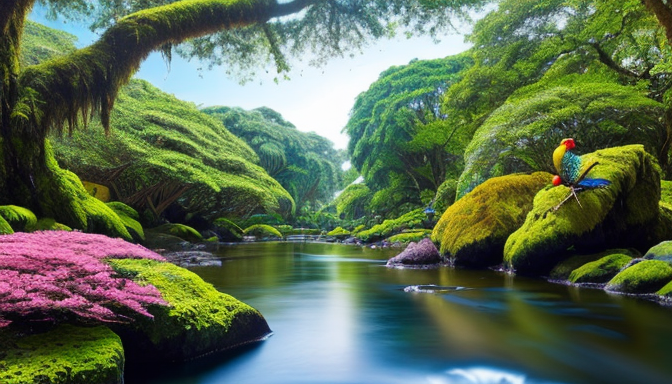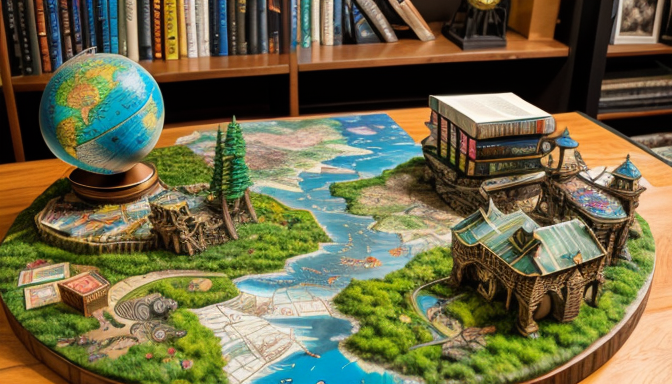Welcome to the fascinating world of worldbuilding, where your imagination is the only limit! Creating a fictional universe can feel like standing at the edge of a vast ocean, with countless possibilities stretching out before you. So, where do you start? Let’s dive into the essential building blocks that will help you craft a universe that not only captivates your audience but also feels alive and immersive.
First things first, let’s talk about geography. The landscape of your world sets the stage for everything that unfolds. Think about the mountains, rivers, and forests that might influence how your characters interact. For instance, a bustling city might thrive near a river, while a secluded village could be hidden deep within a forest. This geography doesn’t just create a backdrop; it shapes cultures, economies, and conflicts.
Next up, we have politics and governance. What kind of systems are in place? Are there kingdoms ruled by monarchs, or perhaps democracies where every voice matters? Understanding the political landscape adds depth to your narrative, as characters navigate alliances, betrayals, and power struggles. It’s like a game of chess where every move counts!
Lastly, don’t forget about mythology and culture. These elements breathe life into your world. Create gods, legends, and traditions that resonate with your characters and your readers. What festivals do they celebrate? What beliefs guide their actions? By weaving these threads together, you’ll create a rich tapestry that draws your audience in and keeps them coming back for more.
In summary, worldbuilding is an intricate dance of geography, politics, and culture, all working together to create a universe that feels real and engaging. So grab your pen, unleash your creativity, and let your imagination run wild!
Creating Compelling Cultures
When it comes to worldbuilding, cultures are the heartbeat of your universe. They breathe life into your stories, making them feel real and relatable. Imagine walking through a bustling market, where the air is filled with the aroma of exotic spices, and the vibrant colors of handmade crafts catch your eye. This is what a well-crafted culture can do—it immerses the audience in a sensory experience that enhances the narrative.
To create compelling cultures, start with traditions. What rituals do your characters observe? Are there festivals that celebrate the changing of seasons or rites of passage that mark significant life events? Think about how these traditions shape the behaviors and values of your characters. For instance, a culture that values community might have regular gatherings where stories are shared, fostering a sense of belonging.
Next, consider the belief systems. What do the people in your world worship? Do they have a pantheon of gods, or do they follow a philosophy that guides their moral compass? These beliefs can influence everything from daily decisions to major political movements. Imagine a society that believes in reincarnation; how would that affect their view on life and death?
Finally, don’t forget about social structures. Who holds power, and how is it distributed? Is there a ruling class, or is it a democracy? Understanding the hierarchy can add depth to your storytelling. For example, a matriarchal society might give women a dominant role in leadership, affecting everything from family dynamics to economic policies.
In summary, creating compelling cultures involves a careful blend of traditions, beliefs, and social structures. By paying attention to these elements, you can craft a world that feels vibrant and alive, captivating your audience and enhancing their experience.

Designing Diverse Ecosystems
When it comes to worldbuilding, ecosystems are the vibrant canvases that bring your universe to life. Imagine stepping into a world where every element, from the towering mountains to the tiniest insects, plays a crucial role in the story. It’s like painting a masterpiece where every brushstroke counts! To create authentic ecosystems, you need to consider the geography, climate, and even the political dynamics that shape them.
Start by envisioning your landscape. Is it a lush rainforest teeming with life, or a barren desert where survival is a daily struggle? Each setting offers unique challenges and opportunities for your characters. For instance, a dense jungle might be home to ancient tribes with rich traditions, while a frozen tundra could host nomadic clans that adapt to the harsh conditions. Each ecosystem can influence the mythology and culture of its inhabitants, creating a rich tapestry of stories.
Let’s break it down with some key considerations:
- Flora and Fauna: What plants and animals exist in your world? How do they interact with each other and with the inhabitants? Consider creating unique species that reflect the characteristics of the environment.
- Climate Zones: Different climates will shape the lifestyle of your characters. A temperate zone might allow for agriculture, while an arid region could lead to nomadic lifestyles.
- Resource Availability: Think about what resources are available in your ecosystem. This can lead to trade, conflict, or cooperation between different cultures.
In summary, designing diverse ecosystems is about more than just creating a backdrop; it’s about crafting a living, breathing world that interacts with its inhabitants. By paying attention to these details, you ensure that your universe is not only immersive but also resonates deeply with your audience.
Frequently Asked Questions
- What is worldbuilding?
Worldbuilding is the art of creating an immersive universe for your stories. It involves developing the setting, cultures, and ecosystems that make your narrative believable and engaging.
- Why are cultures important in worldbuilding?
Cultures are the heartbeat of your world! They shape the characters, influence the plot, and provide depth to your storytelling. Unique traditions and beliefs can resonate with readers, making your universe feel alive.
- How do I create diverse ecosystems?
To craft diverse ecosystems, think about the landscapes, climate, and the flora and fauna that inhabit them. Consider how these elements interact and affect the lives of the inhabitants. This adds authenticity and richness to your world.
- Can I mix different cultural elements?
Absolutely! Mixing cultural elements can lead to fascinating and unique societies. Just ensure that the blend feels organic and serves the story, rather than being a random collection of ideas.
- How detailed should my worldbuilding be?
Detail is key, but don’t overdo it! Focus on the aspects that matter most to your story. A well-crafted world doesn’t need every detail laid out; it just needs to feel consistent and believable.

Recent Comments